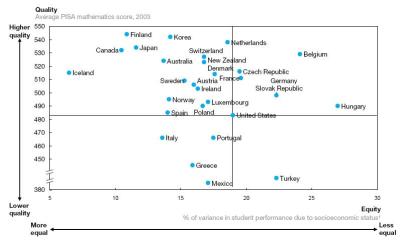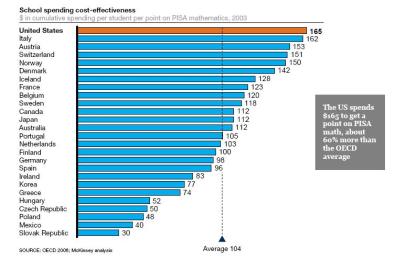The New Yorker recently had a very interesting expose discussing one of the fundamental economic challenges of healthcare reform. (Gawande, Atul, The Cost Conundrum: What a Texas town can teach us about health care, June 1, 2009). Peter Orszag gave a presentation last year at the American Health Lawyers meeting in San Franscisco that I was able to hear. Mr. Orszag, President Obama’s budget director and formerly head of the Congressional Budget Office, has observed repeatedly (and is quoted in this article as saying) that “[n]early thirty per cent of Medicare’s costs could be saved without negatively affecting health outcomes if spending in high- and medium-cost areas could be reduced to the level in low-cost areas.” He, and many healthcare economists’ observe, that there is a tremendous amount of variation in healthcare spending throughout various regions of the country that simply cannot be explained after controling for demographics, illness indexes/cases mixes, cost indexes and other similar factors. And, most importantly, outcomes are no better in higher spending areas.
This New Yorker article paints a narrative story surrounding this frequent observations by looking at case of McAllen, Texas. McAllen has the particular notoriety of having the highest per capital Medicare spending in the nation. I think it is an important read for healthcare counsel because of some of the author’s tangential commentary linking McAllen’s higher per capita spending with a culture that could have support higher incidents of fraud and abuse.
According to the article, McAllen spends (using 2006 data) approximately $15,000 per Medicare enrollee. This is more than twice of what El Paso, Texas, with very similar demographics and population factors, pays. It is also more than twice what the region surrounding the Mayo Clinic spends. Ironically, the per capital Medicare spending is more than McAllen’s per capita income.
The New Yorker author discusses this fact with some local physicians who have no idea of this distinction for their community:
One night, I went to dinner with six McAllen doctors. All were what you would call bread-and-butter physicians: busy, full-time, private-practice doctors who work from seven in the morning to seven at night and sometimes later, their waiting rooms teeming and their desks stacked with medical charts to review. Some were dubious when I told them that McAllen was the country’s most expensive place for health care. I gave them the spending data from Medicare. In 1992, in the McAllen market, the average cost per Medicare enrollee was $4,891, almost exactly the national average. But since then, year after year, McAllen’s health costs have grown faster than any other market in the country, ultimately soaring by more than ten thousand dollars per person. “Maybe the service is better here,” the cardiologist suggested. People can be seen faster and get their tests more readily, he said. Others were skeptical. “I don’t think that explains the costs he’s talking about,” the general surgeon said. “It’s malpractice,” a family physician who had practiced here for thirty-three years said. “McAllen is legal hell,” the cardiologist agreed. Doctors order unnecessary tests just to protect themselves, he said. Everyone thought the lawyers here were worse than elsewhere. That explanation puzzled me. Several years ago, Texas passed a tough malpractice law that capped pain-and-suffering awards at two hundred and fifty thousand dollars. Didn’t lawsuits go down? “Practically to zero,” the cardiologist admitted. “Come on,” the general surgeon finally said. “We all know these arguments are bullshit. There is overutilization here, pure and simple.” Doctors, he said, were racking up charges with extra tests, services, and procedures. The surgeon came to McAllen in the mid-nineties, and since then, he said, “the way to practice medicine has changed completely. Before, it was about how to do a good job. Now it is about ‘How much will you benefit?’ ”
via Annals of Medicine: The Cost Conundrum: Reporting & Essays: The New Yorker.
What is the basis for the higher per capita Medicare spending?
To determine whether overuse of medical care was really the problem in McAllen, I turned to Jonathan Skinner, an economist at Dartmouth’s Institute for Health Policy and Clinical Practice, which has three decades of expertise in examining regional patterns in Medicare payment data. I also turned to two private firms—D2Hawkeye, an independent company, and Ingenix, UnitedHealthcare’s data-analysis company—to analyze commercial insurance data for McAllen. The answer was yes. Compared with patients in El Paso and nationwide, patients in McAllen got more of pretty much everything—more diagnostic testing, more hospital treatment, more surgery, more home care. The Medicare payment data provided the most detail. Between 2001 and 2005, critically ill Medicare patients received almost fifty per cent more specialist visits in McAllen than in El Paso, and were two-thirds more likely to see ten or more specialists in a six-month period. In 2005 and 2006, patients in McAllen received twenty per cent more abdominal ultrasounds, thirty per cent more bone-density studies, sixty per cent more stress tests with echocardiography, two hundred per cent more nerve-conduction studies to diagnose carpal-tunnel syndrome, and five hundred and fifty per cent more urine-flow studies to diagnose prostate troubles. They received one-fifth to two-thirds more gallbladder operations, knee replacements, breast biopsies, and bladder scopes. They also received two to three times as many pacemakers, implantable defibrillators, cardiac-bypass operations, carotid endarterectomies, and coronary-artery stents. And Medicare paid for five times as many home-nurse visits.
The author discusses the high utilization and costs with various hospital executives, who, like the physicians interviewed, also do not know that McAllen is the most expensive place in the country for Medicare beneficiaries. The executives of the hospitals, to the author’s belief, authentically did not know their peculiar notariety and, not even recognizing it as an issue, had no truly thoughtful responses as to why it might be.
Local executives for hospitals and clinics and home-health agencies understand their growth rate and their market share; they know whether they are losing money or making money. They know that if their doctors bring in enough business—surgery, imaging, home-nursing referrals—they make money; and if they get the doctors to bring in more, they make more. But they have only the vaguest notion of whether the doctors are making their communities as healthy as they can, or whether they are more or less efficient than their counterparts elsewhere. A doctor sees a patient in clinic, and has her check into a McAllen hospital for a CT scan, an ultrasound, three rounds of blood tests, another ultrasound, and then surgery to have her gallbladder removed. How [are the hospital executives] to know whether all that is essential, let alone the best possible treatment for the patient? It isn’t what they are responsible or accountable for. Health-care costs ultimately arise from the accumulation of individual decisions doctors make about which services and treatments to write an order for. The most expensive piece of medical equipment, as the saying goes, is a doctor’s pen. And, as a rule, hospital executives don’t own the pen caps. Doctors do.
The article suggests, with only a little explanation, that the variation between communities such as McAllen and, in contrast, El Paso or other lower cost regions (with at least the same if not better quality institutions) might be due to an “anchor tenant theory of economic development.” Certain markets develop their own economic character, similar to how a mall may be defined by its anchor tenant. So, the theory goes, certain “anchor tenants” in a market may allow, for example, the development of regional specialization (e.g., biotechnology development in certain cities – Boston, San Franscisco and not in others with similar apparent resources). Twisting this model a bit, the author posits that the entrepenurial focus of physician medicine in McAllen, changing from the 1990s to present, may be a significant part of the increase in costs. McAllen was near the median in per capita spending a decade ago. Importantly, the author then goes on to point out anecdotal evidence of some serious antikickback statute violations — solicitation by certain unnamed physicians of medical directorships in exchange for referrals to hospitals and home health agencies.
This linkage — which is not well developed by the author — is nonetheless a beware moment. If higher per capita Medicare spending is linked by government enforcement agencies as a proxy for potential higher rates of fraud and abuse behavior, one might see a new horizon for focusing fraud enforcement . Perhaps this is a stretch – but an interesting linkage is being made here by the author. It is all the more important due to the prestige of the publication and that the fundamentals of this story find their genesis in the economic theory of healthcare inflation that is the focus of leaders within the current administration.
The author goes on to make a fairly classical example of the challenges of asymetical information in healthcare coupled with the fee-for-service basis of physician payments:
Providing health care is like building a house. The task requires experts, expensive equipment and materials, and a huge amount of coördination. Imagine that, instead of paying a contractor to pull a team together and keep them on track, you paid an electrician for every outlet he recommends, a plumber for every faucet, and a carpenter for every cabinet. Would you be surprised if you got a house with a thousand outlets, faucets, and cabinets, at three times the cost you expected, and the whole thing fell apart a couple of years later? Getting the country’s best electrician on the job (he trained at Harvard, somebody tells you) isn’t going to solve this problem. Nor will changing the person who writes him the check.
The author aruges that changing the payor (i.e., government plan competitor, single payor system) will not change this problem. Even putting the consumer on the hook through medical savings accounts or high deductible plans won’t solve it (if a physician recommends a cardiac bypass, is the patient going to negotiate with the cardiologist, radiologist, anesthesiologist, cardiothoracic surgeon and hospital over expense or the scope of the procedure?).
Then the author suggest that only flipping the economic model might fix this. The author isn’t quite specific in how this might be accomplished, although he goes to length to contrast the McAllen “anchor-tenant” model with other “anchor-tenant” models of healthcare (e.g., Mayo), suggesting this is the crux of the problem – what kind of medical care provision culture the United States will be developing based upon the economic incentives that are established by insurance payor systems we perpetuate or change through reform. Not by who cuts the check.
This is worth the read because it sets a story narrative for the harder data Mr. Orszag and others have frequently discussed as healthcare reform is debated.
Filed under: AKS, Comparative Effectiveness Rearch, Health Law, Reform, AKS, Conflicts of Interest, Economics, Health Reform, LinkedIn



